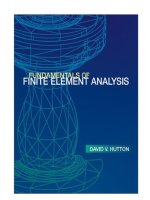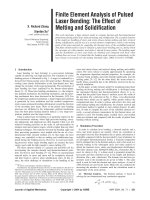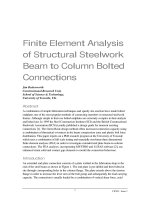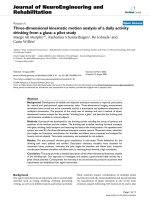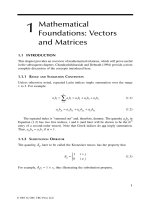Three dimensional finite element analysis of earth pressure balance tunnelling
Bạn đang xem bản rút gọn của tài liệu. Xem và tải ngay bản đầy đủ của tài liệu tại đây (3.08 MB, 251 trang )
THREE-DIMENSIONAL FINITE ELEMENT ANALYSIS
OF EARTH PRESSURE BALANCE TUNNELLING
LIM KEN CHAI
(B.Eng.(Hons.), NUS)
A THESIS SUBMITTED
FOR THE DEGREE OF DOCTOR OF PHILOSOPHY
DEPARTMENT OF CIVIL ENGINEERING
NATIONAL UNIVERSITY OF SINGAPORE
2003
ii
This thesis is dedicated to my mother and father
for their support and love
iii
Acknowledgements
First and foremost, I am deeply grateful to Associate Professor Lee Fook Hou, my
main supervisor, who has provided a motivating, passionate and critical atmosphere
during the many discussions we had. His excellent guidance has enabled me to
understand first hand on the complex issues revolving around this research work and
has given me the courage to clear the issues step-by-step and see the light at the end of
this tunnelling work.
I also wish to thank Associate Professor Phoon Kok Kwang who as my second
supervisor provided constructive comments during the research time as well as the
preliminary version of this thesis.
This study would never be able to get going if not for the funding and research
scholarship from Econ Corporation Limited and the National University of Singapore
respectively. I am grateful to these institutes for providing me the financial support.
Also, special thanks to Land Transport Authority of Singapore who has kindly agreed
to let me access their field logbooks and instrumented data for C704 tunnelling works.
The knowledge, joy and satisfaction that I have benefited during discussions with
research pals from Center for Soft ground Engineering and Center for Protective
Technology are immeasurable. Thanks to pals like Swee Huat, Deon, Sze Han,
Ashish,Wai Kit, Tiong Guan, Poh Ting, Lee Yeong, Joo Kai and William Cheang.
Without you guys, this research period will be soulless.
Last but not least, I would like to express my thanks to Byron Chong, Danny Ang,
Chee Meng, Michael Wong, Flanagan Eng, Joewaye Foo and my family who have
given me the moral support, without whom completion of this thesis would not have
been possible. Yes, it’s a jump on the Singapore River if you know what I mean. Get
ready the Tiger!
iv
Table of Contents
DEDICATION…………………………………………………………………… II
ACKNOWLEDGEMENTS III
TABLE OF CONTENTS IV
SUMMARY VIII
NOMENCLATURE XI
LIST OF TABLES XIX
LIST OF FIGURES XXI
1 INTRODUCTION 1
1.1 BACKGROUND: TUNNELS IN URBAN ENVIRONMENT 1
1.2 EFFECTS OF TUNNELLING ON SURROUNDING GROUND AND STRUCTURES 2
1.3 PREDICTION OF GROUND MOVEMENT ABOVE TUNNELS 3
1.4 OBJECTIVES AND SCOPE OF THIS STUDY 5
2 LITERATURE REVIEW 8
2.1 TUNNELLING USING EARTH PRESSURE BALANCE (EPB) MACHINE 8
2.2 SURFACE SETTLEMENT CAUSED BY SHIELD TUNNELLING 9
2.2.1 Volume loss at Tunnel face 10
2.2.2 Voids in the shield area 11
2.2.3 Voids behind the shield (tail void) 12
2.2.4 Long Term Losses 12
2.3 PREVIOUS STUDIES ON GROUND RESPONSE TO TUNNELLING 13
v
2.3.1 Empirical and Experimental research 13
2.3.2 Analytical research 16
2.3.3 Numerical research 17
2.4 ISSUES TO BE EXAMINED IN THIS STUDY 20
3 PERFORMANCE OF JACOBI PRECONDITIONING IN KRYLOV
SUBSPACE SOLUTION OF FINITE ELEMENT EQUATIONS 26
3.1 INTRODUCTION 26
3.2 STIFFNESS MATRIX AND ITS RELATION WITH ITERATIVE METHODS 28
3.2.1 Drained and Undrained Problems 29
3.2.2 Consolidation Matrix 30
3.2.3 Matrix Properties and Classification of Finite Element Matrix 32
3.3 PREVIOUS RESEARCH ON JACOBI PRECONDITIONING 34
3.4 PROBLEM CONFIGURATION 39
3.4.1 Problem description 39
3.4.2 Finite element model 40
3.4.3 Convergence Characteristics 41
3.5 S
PECTRAL ANALYSIS 46
3.5.1 Effect of boundary conditions 46
3.6 D
RAINED PROBLEMS 47
3.7 UNDRAINED PROBLEMS 50
3.8 CONSOLIDATION PROBLEMS 53
3.9 APPLICATION 57
3.10 PERFORMANCE OF EPCG AND EQMR SOLVER IN LARGER PROBLEMS 58
3.10.1 Test Conditions 58
3.10.2 Results of Benchmark Tests 59
vi
3.11 SUMMARY 61
4 A CASE STUDY OF EPB TUNNELLING 94
4.1 GENERAL INFORMATION OF C704 94
4.2 GEOLOGICAL INFORMATION 95
4.3 GEOTECHNICAL PROPERTIES OF G4 SOILS 96
4.3.1 Basic Properties 96
4.3.2 Strength Parameters 98
4.3.3 Compressibility 99
4.3.4 Permeability 100
4.3.5 Coefficient of Earth Pressure at Rest (K
o
) 100
4.3.6 Depth of Groundwater Table 101
4.3.7 Summary of Geotechnical Soil Investigations 101
4.4 GEOTECHNICAL INSTRUMENTATION OF TUNNEL ROUTE 101
4.5 C704 GROUND RESPONSE 102
4.5.1 Surface ground movement: Trough width & Trough length 103
4.5.2 Subsurface ground movement: Inclinometer & Extensometer 105
4.5.3 Ground Water response 107
4.6 SUMMARY OF FIELD RESULTS 109
5 FINITE ELEMENT STUDY OF C704 EPB TUNNELLING 135
5.1 INTRODUCTION 135
5.2 PROBLEM DEFINITION AND FINITE ELEMENT MESH OF AN EPB EXCAVATION
136
5.3 CONSTRUCTION SEQUENCES 138
5.3.1 Parametric Studies 141
vii
5.3.2 Excavation Step Size 141
5.3.3 Effects of pore-pressure fixity 143
5.3.4 Effects of TBM weight 145
5.3.5 Effects of Face pressure 145
5.3.6 Tail Voids and Lining Stiffness 146
5.4 EFFECTS OF SOIL MODELS 149
5.4.1 Modified Cam Clay model with Elastic Anisotropy effects (MCEA) 150
5.4.2 Hyperbolic Cam clay model (HCC) 151
5.5 HYBRID HCC AND MCEA MODEL 153
5.6 EFFECT OF MATERIAL MODEL ON FE PREDICTION OF TUNNELLING 154
5.6.1 Comparison of results predicted with different soil models 155
5.7 COMPARISON OF 2-D AND 3-D GROUND RESPONSE 156
5.7.1 Soil Types & Parameters 157
5.8 FINITE ELEMENT MESH AND MODELLING 158
5.9 3-D AND 2-D GROUND SURFACE RESPONSE 159
5.10 SUMMARY 163
6 CONCLUSIONS & RECOMMENDATIONS 199
6.1 CONCLUSIONS 199
6.2 RECOMMENDATIONS FOR FUTURE RESEARCH 203
7 APPENDIX A 206
8 REFERENCES 210
viii
Summary
This study investigates the viability of applying three-dimensional finite element
analyses to the prediction of ground movement arising from earth pressure balance
tunnelling. It seeks to address two of the issues involved in three-dimensional finite
element analysis, namely (i) the feasibility of conducting three-dimensional analysis
without resorting to inordinate amounts of computer resources and time, and (ii) the
usefulness of three-dimensional analysis in predicting field movements and its
advantages compared to two-dimensional analysis.
To answer the first issue, two Krylov subspace iterative solvers namely element-by-
element Preconditioned Conjugate Gradient (PCG) and Quasi-Minimal Residual
(QMR) were examined and discussed over the direct method of solving stiffness
matrix arising from geotechnical domains. It also examines the performance of the
Jacobi Preconditioner when used with two Krylov subspace iterative methods. The
number of iterations needed for convergence was shown to be different for drained,
undrained and consolidation problems, even for similar condition numbers. The key to
the problem was due to differences in the eigenvalue distribution, which cannot be
completely described by the condition number alone.
For drained problems involving large stiffness ratios between different material zones,
ill-conditioning is caused by these large stiffness ratios. Since Jacobi preconditioning
operates on degrees-of-freedom, it effectively homogenises the different spatial sub-
domains. The undrained problem, modelled as a nearly incompressible problem, is
much more resistant to Jacobi preconditioning, because its ill-conditioning arises from
i
x
the large stiffness ratios between volumetric and distortional deformational modes,
many of which involve the similar spatial domains or sub-domains. The consolidation
problem has two sets of degrees-of-freedom, namely displacement and pore pressure.
Some of the eigenvalues are displacement dominated whereas others are excess pore
pressure dominated. Jacobi preconditioning compresses the displacement-dominated
eigenvalues in a similar manner as the drained problem, but pore-pressure-dominated
eigenvalues are often over-scaled. Convergence can be accelerated if this over-scaling
is recognised and corrected for.
The second issue was addressed through a back-analysis of an actual three-dimensional
tunnel heading problem, namely the tunnelling operation of Contract 704 of the
Northeast Mass Rapid Transit Line. This back-analysis exercise leads to the following
findings:
(i) Various construction sequences due to Earth Pressure Balance tunnelling
were translated to a set of parametric studies to determine their influences
on the ground response. It is important to consider parameters such as
excavation step-length, face pressure and drainage conditions at the tunnel
excavated boundary. On the other hand, grout stiffness and tunnel boring
machine weight were found not to be significant factors.
(ii) Conventional soil parameters obtained from triaxial and oedometer results
have over-estimated the ground response in relation to the field results.
Application of a non-linear small strain and elastic anisotropy soil within
the yield surface of modified Cam Clay yield much better results.
(iii) A comparative study between two-dimensional and three-dimensional finite
element analyses were examined over a range of stiff and soft soils. A
x
graphical approach depicting two-dimensional ground loss and face area
contraction to the three-dimensional ground responses was crafted to isolate
ground response for different stages of tunnelling excavations i.e. pre- and
post- excavations. By equating the three-dimensional ground settlement
corresponding to a given tunnel heading standoff, the two-dimensional
ground relaxation ratio or face area contraction can be found respectively.
In terms of trough width, the stress-transfer effect of the soil in front of the
tunnel heading gives a narrower three-dimensional trough width as
compared to the two-dimensional one. For soft soils, depending upon the
in-situ K
0
value, when the tunnel is near the monitored section (either ahead
or behind), the three-dimensionally computed trough may be narrower or
wider than the two-dimensionally computed trough. This is due to the
effect of face pressure, which is simulated in the three-dimensional analyses
but not in the two-dimensional analyses.
Key Words: Krylov subspace, iterative, ill-conditioning, three-dimensional finite
element analysis, Earth Pressure Balance tunnelling, ground loss.
xi
Nomenclature
b denotes load vector of real ndf-space
c’ effective stress parameters, cohesion
e
cs
void ratio at Critical state
e
o
initial void ratio
i distance to the point of inflexion of the trough width
'k
1s
effective bulk moduli of the upper or first layer soil
'k
2s
effective bulk moduli of lower or second soil layer
k an empirical constant for trough width
k denotes the permeability matrix
k
1
parameter to take into account the “doming” effect across the
tunnel face, 0 < k
1
< 1
k permeability (isotropically)
k
1
coefficients of permeability of the upper or first soil layer for
consolidation analyses
k
2
The coefficients of permeability of the lower or second soil
layer for consolidation analyses
k
x
permeability in x-direction
k
y
permeability in y-direction
k
s
′ effective bulk modulus of soil skeleton
k
w
bulk modulus of water
κ
(A) condition number of global stiffness matrix A
m is a matrix equivalent of the Kronecker delta
m the OCR exponent of the empirical formulation of G
0
xii
1−
pij
m under-scaled preconditioning factors
n an empirical constant for trough width
n effective stress exponent of the empirical formulation of G
0
n number of joints in the lining ring where n > 4
ndf denotes the number of degrees-of-freedom
p
t
denotes the nodal pore water pressure at the current time step
q
deviator stress
q
f
the deviator stress at failure
r
tunnel radius
t standardised normal random variable
w natural water content
x denotes unknown displacement vector of real ndf-space
x the distance from the centreline of the tunnel driving axis
)0(
x is the initial guess
x
(n)
is the approximate solution vector after n iterations
x, y, z Cartesian ordinates in X, Y and Z directions
x
s
and x
f
respectively the starting and final locations of the tunnel face
A
global stiffness matrix
A
*
preconditioned global matrix
A
e
equivalent to element stiffness matrix K
e
B denotes the matrix of shape function derivatives for
displacement
C is the flow matrix
xiii
C constant of the empirical formulation of G
0
C
c
Compression Index
C
r
Recompression/Swelling Index
C
u
undrained shear strength
D elastic modulus matrix or stress-strain matrix
D diameter of the tunnel
h
E the horizontal elastic Young’s modulus
v
E the vertical elastic Young’s modulus
E initial Young’s modulus
E denotes the shape function derivatives for excess pore water
pressure
E
1
′
elastic Young’s modulus for first layer of soil
E
2
′
elastic Young’s modulus for second layer of soil
E
c
liner modulus
E
g
grout modulus
EI flexural rigidity
Ep excess pitch
F
p
normalised face pressure
G’ shear modulus
G
0
the initial tangential stiffness
G
∞
the tangential stiffness at very large strain
H horizontal displacement
I 2
nd
moment of area of a continuous concrete lining with the
same dimensions
I
j
2
nd
moment of area of each joint
xiv
eff
I effective 2
nd
moment of area of a continuous concrete lining
with the same dimensions
K Bulk Modulus
K an empirical constant dependent on ground conditions
K’ effective bulk modulus
K
1
represents the constraints arising from incompressibility
K
e
the effective stress stiffness matrix
K
o
coefficient of earth pressure at rest
K
s
' represents the stiffness matrix of the soil skeleton
K
w
the bulk modulus of water and n is the porosity of the soil
structure
L is the link matrix
L length of shield
LI Liquidity Index
LL Liquid limit
L
shield
length of the shield machine
M critical state parameter
M
−1
the Jacobi or diagonal preconditioner of global matrix A
N denotes the shape function for excess pore water pressure
N
c
number of iterations needed for relative residual norm (
)(n
r
R ) to
fall below 1×10
−6
N
d
total number of degrees-of-freedom for drained or undrained
case
N
broms
stability number used by Broms and Bennermark (1967)
)(n
i
R relative “improvement” norm
xv
)(n
E
R relative energy error norm
)(n
r
R relative residual norm
PI Plasticity Index
PL Plastic Limit
R
sr
the step ratio
shield
excav
L
Z
S' effective stiffness matrix for consolidation matrix
S
0
the initial tangential stiffness of the q vs ε
s
curve
S
∞
the tangential stiffness at very large strain
S settlement obtained from numerical results
S
max
maximum settlement obtained from numerical results
T tridiagonal matrix
V
i
trough volume
f
V face volume Loss
V
o
tunnel opening volume (πr
2
)
0
Y the depth from the ground surface to the springline level
Z tunnel driving in z-direction of the Cartesian-ordinates.
excav
Z excavation step sizes
2-D two-dimensional
3-D three-dimensional
EPB earth pressure balance
EPCG element-by-element PCG
EQMR element-by-element quasi-minimal residual
xvi
FE finite element
FEA Finite element analysis
FEM finite element model
HCC hyperbolic small strain modified Cam Clay model
HMCEA hyperbolic small strain coupled with elastic anisotropy
formulated within modified Cam Clay
MCC modified Cam Clay
MCEA modified Cam Clay with elastic anisotropy factor
MINRES minimum residual
PCG Preconditioned conjugate gradient
QMR quasi-minimal residual
SYMMLQ symmetric LQ
TBM tunnel boring machine
⋅⋅, denotes the inner product
2
⋅ denotes the matrix 2-norm
max
u maximum displacement magnitude
max
p maximum pore pressure magnitude
⋅
max
j
the maximum absolute value term over index-j
F( )
represent the cumulative distribution function of a standardised
normal random variable
xvii
∆f denotes the nodal load increment
∆
p denotes the excess pore water pressure increment
∆
u denotes the displacement increment
∆t denotes the time step
∆
x
distance of step-size adopted in the step-by-step incremental
finite element analysis
max
λ
maximum eigenvalue
min
λ
minimum eigenvalue
max
σ
maximum singular value
min
σ
minimum singular value
σ
s
Overburden Pressure at tunnel axis
σ
τ
Tunnel supporting pressure at tunnel axis
ν Poisson’s ratio
ν’ effective Poisson’s ratio
φ’ effective stress parameters, internal friction angle
ε
∞
the shear strain at yielding
ε
s
deviator strain
ε
s
the shear strain
ε
percentage ground loss
γ
bulk
bulk unit weight
γ
w
unit weight of water
2
α
anisotropy factor
xviii
δ
x
maximum inward axial displacement of soil at the tunnel face
δ
settlement magnitude
max
δ
maximum settlement
κ
slope of the isotropic unload-reload line
λ
slope of the isotropic normal compression line
xi
x
List of Tables
Table 2.1 Summary of Analytical research 21
Table 2.2a Values of i for settlement trough 22
Table 2.2b Values of i for subsurface trough 22
Table 2.3 Summary on Numerical research 23
Table 3.1 Computational cost for solving indefinite matrix system 63
Table 3.2 Physical properties for drained cases 63
Table 3.3 Physical properties for undrained cases 64
Table 3.4 Physical properties for consolidation cases 64
Table 3.5 Comparison of iterations for various types of matrices 65
Table 3.6 Maximum magnitudes of nodal displacement and excess pore pressure for
the unconditioned matrix in CONSO3 65
Table 3.7 Maximum magnitudes of nodal displacement and excess pore pressure for
the preconditioned matrix in CONSO3 65
Table 3.8 Condition number for CONSO3 corresponding to the Jacobi preconditioned,
under-scaled and over-scaled matrix 66
Table 3.9 Physical Properties of Different Meshes 66
Table 3.10 Typical Soil Parameters (Mohr Coulomb constitutive soil model) 66
xx
Table 3.11 Typical Concrete Parameters (Isotropic Elastic model) 66
Table 4.1 Physical Description of the Granite Formation 110
Table 4.2 Sub-layers of G4 110
Table 4.3 Typical G4 soil parameters found in C704 111
Table 4.4 Monitoring Frequencies for Field Instruments. 111
Table 4.5 Maximum Settlement due to single driven south bound tunnel 111
Table 5.1 Typical Soil parameters used for finite element analysis 166
Table 5.3 Specification of the EPB shield used in C704 166
Table5.4 Properties of EPB used in FEM 167
Table 5.5 Summary of UUR results for Serangoon Station 167
Table 5.6 Typical soil parameters for C704 FEA 167
Table 5.7a Summary of Case I soil properties (G4) 168
Table 5.7b Summary of Case II soil properties (OA) 168
Table 5.7c Summary of Case III soil properties (S3) 168
Table 5.7d Summary of Case IV soil properties (MC) 168
Table 5.8 Type A and Type B K
0
conditions 168
Table 5.9 Ground relaxation ratio and the tunnel face position 169
xxi
List of Figures
Figure 2.1 A schematic drawing of the typical EPB machine (after Howden, 1996) 24
Figure 2.2 Various Components of ground loss (after Nelson, 1985) 24
Figure 2.3 Pitching of shield causing additional shield and tail loss (after Nelson,
1985) 25
Figure 2.4 Green field effect due to tunnelling (after Yeates, 1985) 25
Figure 3.1 Pseudocode for the CG (modified after Shewchuk,1994) 67
Figure 3.2 Pseudocode for the EBE-PCG (modified after Barett et al.,1994) 68
Figure 3.3 Pseudocode for MINRES (after Vorst, 2002) 69
Figure 3.4 Pseudocode for SYMMLQ (after Vorst, 2002) 70
Figure 3.5 Pseudocode for EBE-symmetric QMR (modified after Barett et al.,1994) 71
Figure 3.6 Typical 3D FE mesh (quadrant symmetric) 72
Figure 3.7a Behaviour of various norms using EPCG (Case DR1, κ(A
*
) = 4.445×10
2
)
73
Figure 3.7b Behaviour of various norms using EQMR (Case DR1, κ(A
*
) = 5.618×10
2
)
73
Figure 3.8a Behaviour of various norms using EPCG (Case DR6, κ(A
*
) = 2.087×10
5
).
74
Figure 3.8b Behaviour of various norms using EQMR (Case DR6,
κ(A
*
) = 3.492×10
5
)
74
Figure 3.9a Behaviour of various norms using EPCG (Case UD1, κ(A
*
) = 4.161×10
2
).
75
Figure 3.9b Behaviour of various norms using EQMR (Case UD1, κ(A
*
) = 5.488×10
2
)
75
xxii
Figure 3.10a Behaviour of various norms using EPCG (Case UD4, κ(A
*
) =
1.042×10
5
) 76
Figure 3.10b Behaviour of various norms using EQMR (Case UD4, κ(A
*
) =
2.400×10
5
) 76
Figure 3.11a Behaviour of various norms using EQMR (Case CONSO1, κ(A
*
) =
3.261×10
3
) 77
Figure 3.11b Behaviour of various norms using EQMR (Case CONSO3, κ(A
*
) =
2.193×10
10
) 77
Figure 3.12a Variation of iteration number with condition number for EPCG
algorithm on drained and undrained problems 78
Figure 3.12b Variation of iteration number with condition number for EQMR
algorithm on drained, undrained and consolidation problems 78
Figure 3.13a Cumulative distribution of eigenvalues in problems DR1 and DR6 before
and after "partial Jacobi" preconditioning 79
Figure 3.13b Cumulative distribution of eigenvalues in problems DR1, DR4, DR6 and
DR7 before "partial Jacobi" preconditioning 79
Figure 3.14a Parts of the unconditioned global stiffness matrix from DR1 80
Figure 3.14b Parts of the unconditioned global stiffness matrix from DR6 80
Figure 3.15 Cumulative distribution of eigenvalues in problems DR1, modified DR6
and DR6 before and after “full Jacobi” preconditioning 81
Figure 3.16 Eigenvectors corresponding to (a) the 20-percentile eigenvalue and (b) the
80-percentile eigenvalue, of DR6 before conditioning 82
Figure 3.17 Eigenvectors corresponding to (a) the 20-percentile eigenvalue and (b) the
80-percentile eigenvalue, of DR12 before conditioning 82
xxiii
Figure 3.18 Cumulative distribution of eigenvalues in problems DR1 and DR6 before
and after “full Jacobi” preconditioning 83
Figure 3.19 Parts of the preconditioned global stiffness matrix from DR6 83
Figure 3.20a Parts of the unconditioned global stiffness matrix from UD4 84
Figure 3.20b Parts of the preconditioned global stiffness matrix from UD4 84
Figure 3.21 Eigenvalue distribution of some undrained problems before and after
Jacobi preconditioning 85
Figure 3.22 Eigenvectors corresponding to (a) the 3
rd
smallest eigenvalue and (b) the
80-percentile eigenvalue, of UD4 before preconditioning 86
Figure 3.23 Eigenvectors corresponding to (a) the 3
rd
smallest eigenvalue and (b) the
80-percentile eigenvalue, of UD4 after preconditioning 86
Figure 3.24 Cumulative distribution of eigenvalue moduli for some consolidation
cases before and after preconditioning 87
Figure 3.25 Parts of the unconditioned global stiffness matrix from CONSO3 87
Figure 3.26 Cumulative distribution of eigenvalue moduli for some consolidation
cases before and after preconditioning 88
Figure 3.27 Eigenvalue distribution of CONSO3 before and after different variants of
diagonal preconditioning 88
Figure 3.28a Single Tunnel Mesh ( 3120 3-D elements) 89
Figure 3.28b Tunnel geometry closed-up 89
Figure 3.29a Twin-Tunnel Mesh (9920 3-D elements) 90
Figure 3.29b Twin-Tunnel geometry closed-up 90
Figure 3.30a CPU runtime for single tunnel drained and undrained cases 91
Figure 3.30b CPU runtime for single tunnel consolidation cases 91
Figure 3.30c CPU runtime for twin tunnel drained and undrained cases 92
xxiv
Figure 3.30d CPU runtime for twin tunnel consolidation cases 92
Figure 3.31 Average timings using various solvers 93
Figure 4.1 Locations of C704, North East Line in Singapore 112
Figure 4.2 Geological Map of Singapore Island (PWD, 1976) 113
Figure 4.3 Subsurface soil profile of C704 project 114
Figure 4.4 Variation of physical properties against depth at C704 tunnel route
(Serangoon to Woodleigh) 115
Figure 4.5 Liquidity Index of G4 soil 116
Figure 4.6 Atterberg Limits – Soil Type G4. 117
Figure 4.7 Variation of Drained and Undrained strength parameters against Depth at
C704 for soil type G4 118
Figure 4.8 Typical grain size distributions for G4 soil at C704 tunnel route (Serangoon
to Woodleigh) 119
Figure 4.9 Variation of Compression parameters against depth. 120
Figure 4.10 Variation of (i) Permeability against depth (ii) Permeability against SPT
‘N’. 121
Figure 4.11 Horizontal effective stress from pressuremeter results (from Dames &
Moore (1983) and C704 of soil type G4. 122
Figure 4.12 Ground-water level in standpipes. 123
Figure 4.13 Monitoring sector in C704 124
Figure 4.14 Layout of instruments in pile-group in C704 125
Figure 4.15 Settlement width characteristics of C704: (a) normalised settlement
behaviour with i= 0.5k
o
b) Comparison with other field data as reported in CIRIA,
Project Report 30 126
Figure 4.16 Settlement behaviour of the monitored “green-field” condition. 128
xxv
Figure 4.17 Comparison of normalised field data with normal cumulative distribution
curve. 129
Figure 4.18 (a) Lateral and (b) longitudinal subsurface movements before and after
southbound tunnelling (inclinometer I5101) 130
Figure 4.18c Longitudinal subsurface movements before and after southbound
tunnelling (inclinometer I5102) 131
Figure 4.19 Cross sectional view of the magnetic extensometer locations (not to scale)
in section L3 132
Figure 4.20 Subsurface vertical movement a) MX5102 & MX5101, b) MX51011 (SB)
and c) MX51011 (NB) 133
Figure 4.21 Measured pore water pressure response in section a) L1, b) L4, and c) L5
during tunnelling. 134
Figure 5.1 Typical finite element mesh 170
Figure 5.2a Tunnel excavation through jacking of piston ram 171
Figure 5.2b Retraction of piston ram and installation of concrete lining 171
Figure 5.2c Shield advanced through jacking of piston ram 171
Figure 5.3a FE construction sequences for EPB modelling (Stage A) 172
Figure 5.3b FE construction sequences for EPB modelling (Stage B) 172
Figure 5.4 Excavation sequences for various excavation step sizes 173
Figure 5.5 Trough length response due to different excavation step sizes 174
Figure 5.6 Trough width response due to different excavation step sizes 174
Figure 5.7 Trough length response due to pore pressure fixity 175
Figure 5.8 Trough width response due to pore pressure fixity 175
Figure 5.9 Total pore pressure variations due to pore pressure fixity 176
Figure 5.10 Trough length response due to EPB shield’s weight 176
